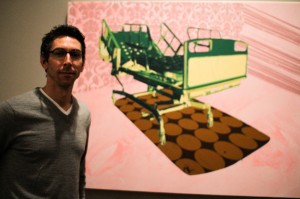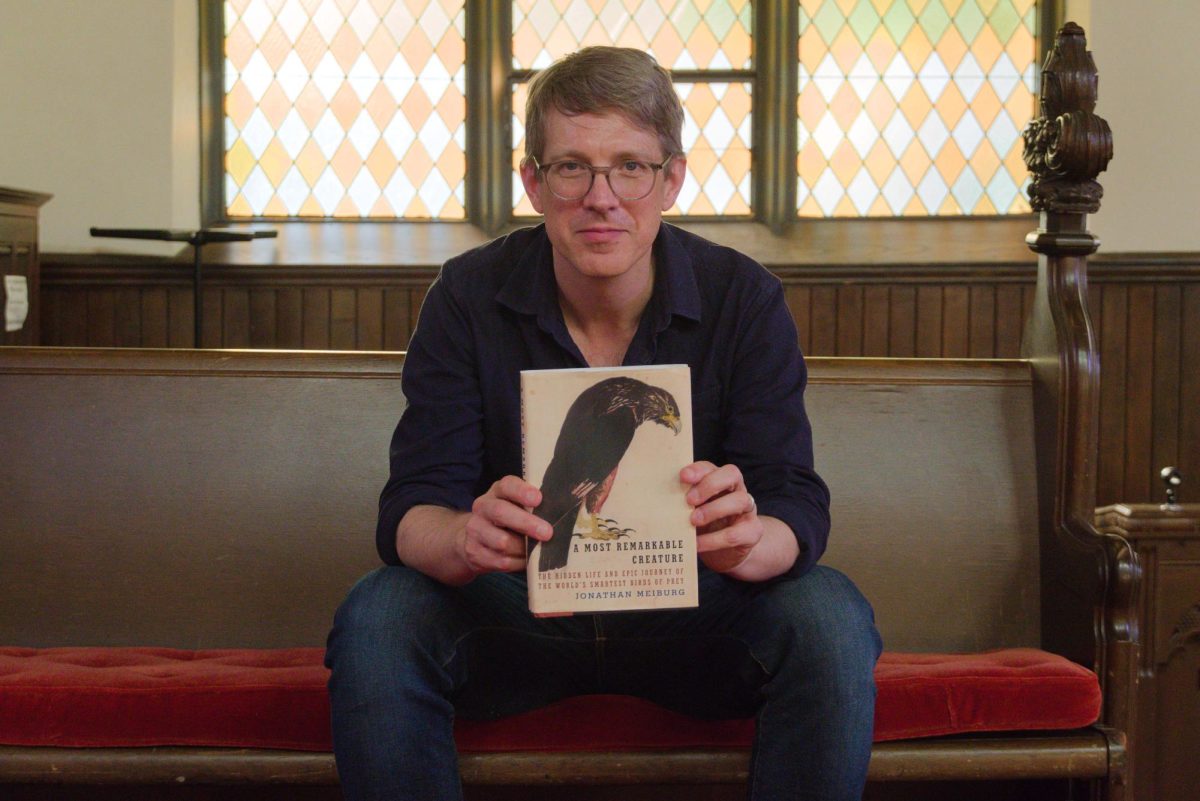By Hannah Condon
condonha@grinnell.edu
Friday, November 2 marks the opening of two shows by Grinnell faculty members in Faulconer Gallery.
Craig Quintero, Theater, developed “we’re all in this together,” an installation space where visitors are encouraged to engage creatively with the arts.
“Breach,” an exhibition by Andrew Kaufman, Art, examines the related themes of containment, contamination and breach in a variety of mediums, including painting, installation and video.

Both artists took an alternative approach to art that reflects the randomness and ambiguity of everyday life.
Along with fellow Grinnell faculty members, a professor and an alumnus from the University of Iowa and members of the Riverbed Theatre Company in Taiwan, Quintero has transformed half of Faulconer Gallery into an installation space that consists of three rooms.
Visitors first enter a dim, nostalgic room reminiscent of a grandparent’s basement—it’s a bit creepy, yet cozy. After passing through this first room, visitors enter a second room that is full of props and costumes that could be old family relics.
A sign hangs on the wall of the second room that encourages visitors to use the props and costumes to create art. They can take photographs of the art that they create with cameras available at the security desk. The third room of the exhibition will display some of the photographs that the visitors take.
The interaction between viewers and art injects an element of excitement, producing spontaneous and unforeseen results.
“I think that that’s exciting. It requires you to step out in faith, but by stepping out in faith, I think you sort of allow exciting things to happen,” Quintero. “You allow chance to work, chance to be a collaborator in your piece as well.”
Collaborating with chance brings realism into Quintero’s art. While performance art often centers on a linear narrative, Quintero believes that is not an accurate representation of everyday life.
“I’d say that that’s not realism, that’s fiction. The realism of our everyday life is that events happen randomly,” Quintero said.
The randomness of everyday life leads to ambiguity, another influence on Quintero.
“We’re constantly inundated with images and experiences, and our brain is constantly working. And it’s not something that I think we consciously control or dictate. Our mind is spinning, and I think it’s exciting to let the subconscious work, to let the subconscious become concrete,” Quintero said. “And I think in that process, oftentimes, I’m not sure what it means—I’m not sure why. You trust your instincts.”
Quintero instinctively chose the props that appear in the installation, many of which he came across by chance. The old carpet that appears in the show was found in a hotel in Marshalltown.
What unites this seemingly random assortment of objects is that they all seem to have a tale to tell.
“I think, in choosing the objects, I was trying to choose objects that already were telling stories, interesting stories, and that had a life of their own,” Quintero said.
The other half of Faulconer Gallery contains Kaufman’s show “Breach” in which he examines containment, an idea that Kaufman has been fascinated by for as long as he can remember.
Growing up during the onset of the AIDS epidemic, Kaufman noticed that society developed a heightened awareness of exchanges between people and a fear that those exchanges could be deadly. This sparked his interest in containment and personal space.
“That started the idea,” Kaufman said, “This idea that our bodies are vessels.”
Some of his work is an obvious representation of the idea that the human body is like a container. His work entitled “Kiss” is composed of water-filled vessels joined together, like bodies coming together in a sexual exchange.
Over the years, Kaufman’s conception of containment has evolved. He now also explores the ideas of contamination and breach in relation to containment.
The levees being breached during Hurricane Katrina began his exploration of the idea of breach.
“I became interested in the idea of breach as a puncture in containment,” Kaufman said.
Kaufman is interested in exploring how the moment of breach often causes a paradigm shift in those who experience it.
“What I’m interested in with this idea of breach is the mind shift that happens in a moment of catastrophe like that, of a breach, where your world perspective and your world view rapidly changes,” Kaufman said.
Kaufman’s “Endurance” series is a representation of the concept of breach. Part of this series is composed of works in which Kaufman drew to the point of exhaustion, sometimes using weighted poles to decrease his endurance. The moment at which he could no longer draw represents the moment of breach.
“That moment of breach happens when you struggle. There’s a beauty in that struggle… How long can you actually put your arms out in front of you before you start shaking? I’m interested in that struggle, that obvious effort. And then when they fall, that becomes the breach, to me.”
Some of the Endurance series is shown in video form playing from small monitors in an installation piece. Breach is also represented here by cords—the drawings are no longer contained by the monitors and spill onto the floor.
Many of Kaufman’s works are not obvious representations of the concepts that he is exploring. Like Quintero, he prefers ambiguity.
“I think the world exists in ambiguity, and I don’t want to be held by the hand and kind of pulled along to a specific meaning all the time. It starts to turn it into something that doesn’t engage me intellectually. I guess I find value in these slight shifts in trying to decipher what does it mean for me,” Kaufman said. “What is the artist’s intention, and what are they working around? Those to me become points of a conversation that could happen, and I’m interested in that conversation.”
The artists’ shared belief that ambiguity characterizes everyday life is not all that unites the two exhibitions. Although they are in the gallery at the same time primarily for convenience—each show takes up half of the space—Leslie Wright, director of Faulconer Gallery, has found unintentional commonalities between the shows, both visually and ideologically.
“I think it is interesting to look at the two of them now, where in [“we’re all in this together”] you’ve got this interesting rug and [Kaufman] has a lot that has to do with carpet in some of his paintings,” Wright said.
“I think the two of them are going to create some interesting resonances,” Wright said. “One you can actively participate in, the other you can imagine what would happen if you actively participated in it.”
























































JAMES DeForest • Nov 2, 2012 at 7:54 pm
Enjoyed the article.In some ways I can identify with the process of ambiguity and “a breach” from activities of life involving work and the constant struggle to continue to learn more and more in order to keep up with ,and compete with, the younger and “smarter” generation when I really just want to stop and say “I’ve had ENOUGH!”
I’m sure this wil be a successful show.